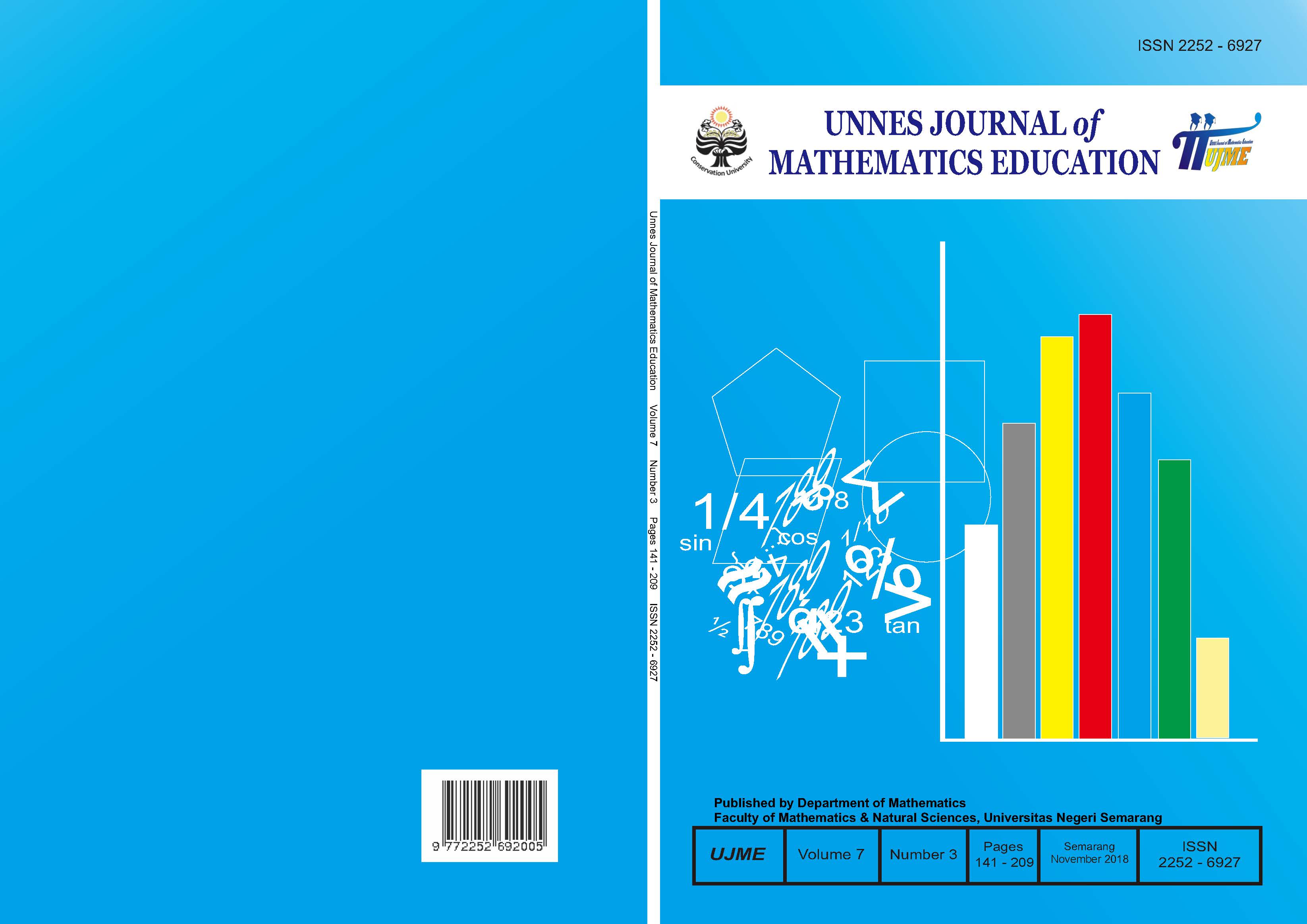An analysis of mathematical problem solving ability based on hard work character in mathematics learning using connecting organizing reflecting extending model
##plugins.themes.academic_pro.article.main##
Abstract
Mathematical problem-solving ability is one of the goals of mathematics learning. However, the mathematical problem-solving ability of students is still lacking. Therefore, this research was conducted (1) to observe whether students problem-solving ability on CORE-modeled mathematical learning passed the minimum criteria of mastery learning or called as KKM included average mastery and proportion mastery, (2) compare the application of CORE model and Jigsaw model on students problem solving ability, (3) increase the mathematical problems solving ability using CORE model and (4) analyze the mathematical problem solving ability observed from hard work character using CORE model. This research used a mixed method with the concurrent triangulation method. The population was VIII grade student of SMPN 12 Semarang. The results showed that: (1) the mathematical problems solving ability on CORE-modeled mathematical learning passed the minimum criteria of mastery learning included average mastery and proportion mastery, (2) students problem solving ability on CORE mathematics learning model and those on Jigsaw mathematics learning model are equal, (3) there was an increase in the mathematical problems solving ability on mathematics learning after CORE model being applied, (4) student who had worked hard trait in the 1st group on mathematics learning showed the ability to solve mathematical problems was better than those in 2nd and 3rd group on mathematics learning.
##plugins.themes.academic_pro.article.details##
References
Ariyani, D. F., Wuryanto, W., & Prabowo, A. (2013). Keefektifan Pembelajaran MMP Terhadap Kemampuan Pemecahan Masalah Disertai Identifikasi Tahap Berpikir Geometri. Unnes Journal of Mathematics Education, 2(2), 71-77.
Pendidikan, B. S. N. (2006). Standar isi. Jakarta: BSNP.
Curwen, M. S., Miller, R. G., White-Smith, K. A., & Calfee, R. C. (2010). Increasing teachers' metacognition develops students' higher learning during content area literacy instruction: Findings from the read-write cycle project. Issues in Teacher Education, 19(2), 127-151.
Fitriastuti, W. (2014). Peningkatan Sikap Kerja Keras dan Tanggung Jawab Siswa dalam Pembelajaran Matematika Melalui Strategi Course Review Horay.
Heh, J. S. (1999). Evaluation model of problem solving. Mathematical and Computer Modelling, 30(11-12), 197-211.
Ibrohim, M. (2017). Analisis Kemampuan Pemecahan Masalah dan Karaker Kerja Keras Melalui Pembelajaran Discovery Learning dengan Strategi Scaffolding dengan Materi Trigonometri. Tesis: Pendidikan Matematika UNNES.
Jacob, C. (2011). Refleksi pada Refleksi Lesson Stady (Suatu Pembelajaran Berbasis-Metakognisi), 1-15.
Kemendiknas. (2010). Pengembangan Pendidikan Budaya dan Karakter Bangsa (ebook). Jakarta: Kementrian Pendidikan Nasional.
Khafidhoh, S. (2014). Penerapan Model Connecting, Organizing, Reflecting, Extending (CORE) untuk Meningkatkan Kemampuan Pemecahan Masalah Matematika Siswa pada Materi Bangun Ruang Sisi Lengkung Kelas IX MTs Negeri Mojokerto. Skripsi: Jurusan Pendidikan Matematika dan Ilmu Pengetahuan Alam (PMIPA) Universitas Islam Negeri Sunan Ampel Surabaya.
Larch, M., Bernard, K. M., & Tatar, B. (2014). Hard work, and More: How to successfully conduct adjustment with official assistance (No. 514). Directorate General Economic and Financial Affairs (DG ECFIN), European Commission.
Mullis, I. V., Martin, M. O., Foy, P., & Arora, A. (2012). TIMSS 2011 international results in mathematics. International Association for the Evaluation of Educational Achievement. Herengracht 487, Amsterdam, 1017 BT, The Netherlands.
Polya, G. (2004). How to solve it: A new aspect of mathematical method (No. 246). Princeton university press.
Savitri, S. N., Rochmad, R., & Agoestanto, A. (2013). Keefektifan Pembelajaran Matematika Mengacu Pada Missouri Mathematics Project Terhadap Kemampuan Pemecahan Masalah. Unnes Journal of Mathematics Education, 2(3), 28-33.
Driana, E. (2012). Gawat Darurat Pendidikan. Kompas, 14 Desember 2012. Hlm. 6.
Sudjana, N. (2009). Penilaian Hasil Proses Belajar Mengajar. Bandung: PT Remaja Rosdakarya Offset.
Surya, E., & Putri, F. A. (2017). Improving Mathematical Problem-Solving Ability and Self-Confidence of High School Students through Contextual Learning Model. Journal on Mathematics Education, 8(1), 85-94.
Taneo, P. N., Suyitno, H., & Wiyanto, W. (2015). Kemampuan Pemecahan Masalah dan Karakter Kerja Keras Melalui Model Savi Berpendekatan Kontekstual. Unnes Journal of Mathematics Education Research, 4(2), 122-129.
Utami, T. (2017). Penerapan Model Pembelajaran Connecting, Organizing, Reflecting, Extending (CORE) untuk Meningkatkan Kemampuan Pemecahan Masalah Matematika Siswa pada Materi Trigonometri (Penelitian dilaksanakan di kelas XI Multimedia 2 SMK Negeri 7 Surakarta Tahun Ajaran 2016/2017 (Doctoral dissertation, Universitas Sebelas Maret).
Warli., & Fadiana, M. J. (2014). Design of Mathematic Learning Based on Cognitive. Makalah. In Proceeding of International Conference On Research, Implementation And Education Of Mathematics And Sciences 2014. Yogyakarta State University, 543-552.
Wulandari, A. N., YL Sukestiyarno & Sugiman. (2013). Pengembangan Karakter dan Pemecahan Masalah Melalui Pembelajaran Matematika dengan Model TAPPS. Unnes Journal of Mathematics Education, 2(3), 40-46.
